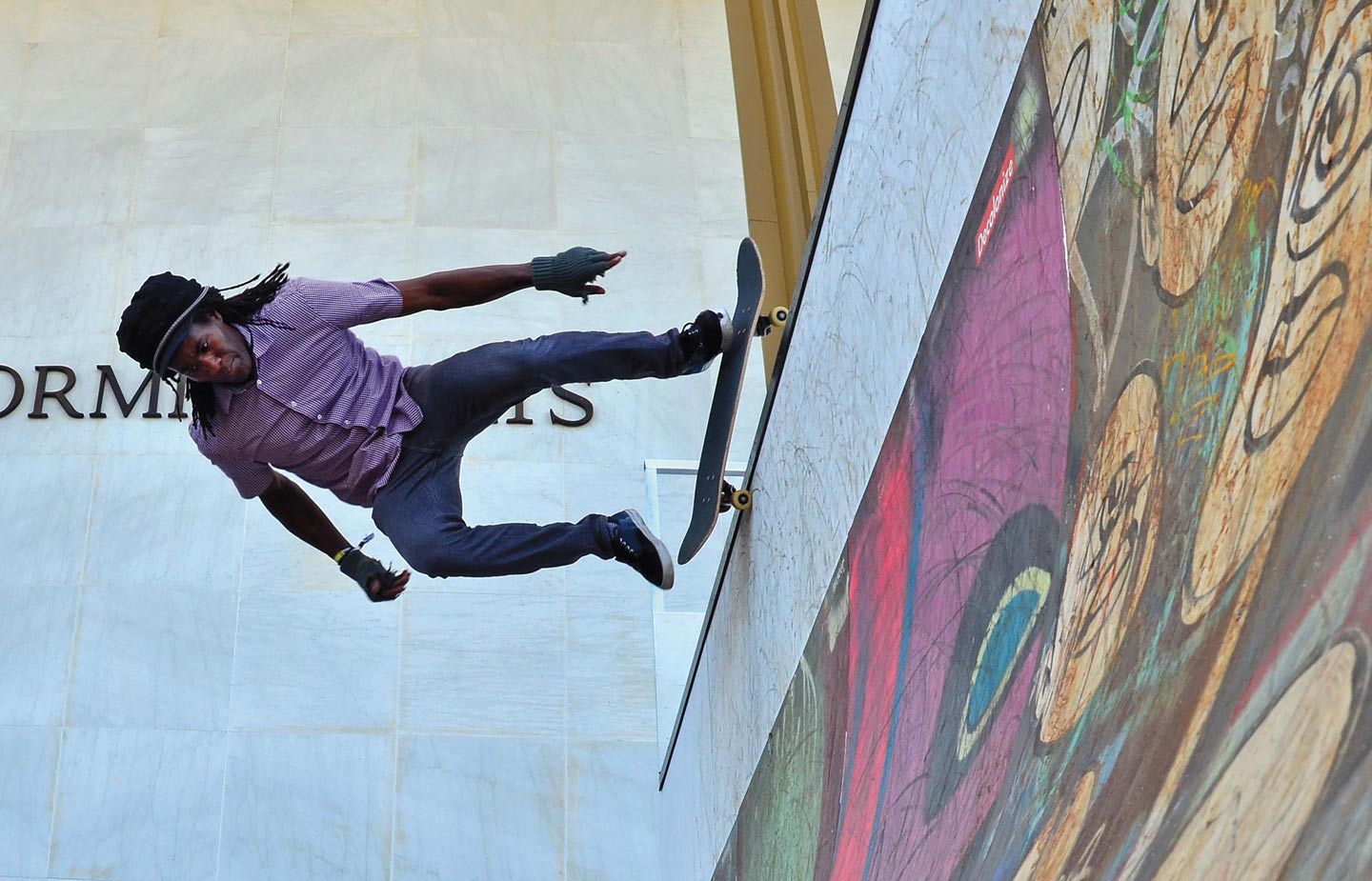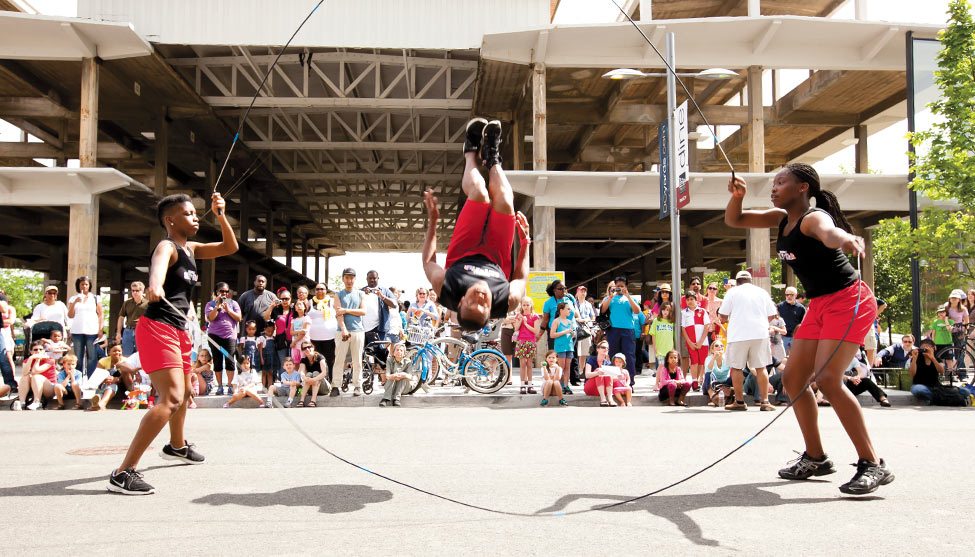Art for Everyone
Garth Ross ’93 helped transform the Kennedy Center. Now he’s ready for Yale.
As the rusty metal door creaked open and Garth Ross ’93 stepped inside, he could tell this place was unique.
The entrance, unmarked and inconspicuously nestled in the shadows of a dark alley near Washington, D.C.’s newly built convention center, provided access to the vibrant underground skateboarding and arts space, known as “Fight Club,” that occupied a neglected building in the Shaw neighborhood of D.C.
Fight Club was a bubbling cauldron of improvisational creative spirit, showcasing live music, visual art and independent film screenings, all centered around the core energy of the city’s skateboarding culture and the diverse mix of skaters who glided, jumped and seemingly defied gravity on the various ramps and half-pipes. Ross was impressed with the ethnic, gender and generational diversity he saw, and the uninhibited commitment to free expression.
So in 2015, six years after that initial visit to the now-defunct Fight Club, Ross oversaw the construction of a temporary skateboarding park outside the John F. Kennedy Center for the Performing Arts. Ross, who just completed a 21-year run this spring as the Kennedy Center’s vice president for community engagement, organized the 10-day festival “Finding a Line: Skateboarding, Music and Media.” The festival mashed together various genres of musical performances, art and, of course, skateboarding.
The idea of exploring skateboarding at the Kennedy Center, a venue typically associated with black-tie affairs and an adherence to more traditional programming such as opera and ballet, might seem counterintuitive to some. But Ross says “Finding a Line” was actually consistent with the original intent of the center, which sought to create a venue that adapts and evolves over time to showcase new art forms as they emerge on the American cultural landscape. For Ross, exposing audiences to vastly different cultures through performance is essential for promoting positive social change and building community relationships.
“If there are big, undeniable areas of culture that are uniquely American that are not present at the Kennedy Center, then that needs to be addressed,” Ross argues. “As the national cultural center, we need to make sure we provide a platform for the full breadth of American culture, particularly for something as prominent as skating culture
or hip-hop.”
THIS PASSION for creative collaboration and blending genres can be traced back to Ross’ days at Connecticut College.
Initially uncertain of what he wanted to study at Conn, Ross ultimately majored in English with a music minor, and began to hone his skills as a vocal performer, singing with the College’s all-male a cappella group, the Co Co Beaux. All the while, his interests in folk, pop, gospel and other kinds of music continued to build.
By the time graduation day was upon him, Ross was convinced he wanted to pursue a career as a professional musician. The question was: where?
His girlfriend at the time (now wife), Christy Halvorson Ross ’93, was originally from D.C., and they decided to move there to be near her family.
“What’s great about D.C. is that it has a huge music scene, but it isn’t driven by the record industry like it is in New York, L.A. and Nashville,” Ross says.
“I really wanted to try the life of a musician, so I was playing in five different ensembles. I was a member of the [Washington] National Cathedral Choir of Men and Boys. I was the member of a pop-vocal sextet. I had a band that I fronted. I was in two gospel choirs and performed solo as a singer-songwriter,” he recounts.
“I was performing on street corners, at clubs, at festivals, in cathedrals and at arts centers like the Kennedy Center whenever I could.”
After two and a half years of making his living primarily as a musician, Ross says the schedule began to wear on him. With his career edging near the point where he would have been spending a substantial amount of time touring, he stepped back and appraised his situation.
He concluded that the element of being a full-time artist he valued most was collaborating with all the different artists he had been able to work with and make music with since he’d moved to Washington. That’s when Ross’ interest in arts administration emerged.
To pay the bills and develop his administrative skills, Ross worked as an administrative assistant with a search firm, and his boss, aware that Ross had ambitions of working in the arts, allowed him to take long lunches every Monday so he could go on job interviews.
Less than a year later, opportunity presented itself. The Kennedy Center, under the guidance of new leadership, began to build on its legacy of diverse and inclusive programming, and prioritized expanding accessibility to the arts. This created the perfect opening for Ross to join the center as a programming and production assistant for the newly created Millennium Stage. The performance series, which still hosts free shows every night by local, national and international performers from the worlds of dance, music and theater, has been a wildly successful community arts initiative.
When Ross arrived for his interview, he was thrilled to discover that the person in charge of hiring was not only somebody he’d come to know a bit from his experience performing at the Kennedy Center but also happened to be a Conn grad—Shelley Brown ’88. Ross got the job.
“There’s no question that being a Camel made an immeasurable difference in my life at that particular moment. It was phenomenal,” he says.
TO FULLY APPRECIATE the diversity of programming at the Kennedy Center, exploring the early history of the institution is helpful.
In 1958, President Eisenhower signed legislation to create a “National Cultural Center,” and it was renamed as a memorial to President John F. Kennedy after his assassination in 1963, before finally opening in 1971. The center was meant to reflect the ever-changing art and culture of every area of American society, not just the traditional forms like opera and ballet, and, in fact, looking back on the Kennedy Center’s inaugural season, there were some surprising performances.
During the course of one week toward the end of the first season, the center hosted performances by Pink Floyd, Marvin Gaye and Arlo Guthrie.
“The common perception of the Kennedy Center is that it has always focused exclusively on heritage arts performances,” says Ross. “But in those early years, the center hosted some really important pop culture and counterculture performers of that era.”
As time went on, the National Symphony Orchestra, along with the Washington National Opera, relocated to the center, contributing to a shift in the center’s audience. By the mid-1990s, Ross felt strongly that the Kennedy Center should return to its roots.
“The voice is the most ubiquitous instrument throughout various cultures, so as a vocalist I had taken this unusual journey that allowed me to sing with so many different people,” Ross says. “What I noticed is that at most arts centers, programming didn’t reflect the level of heterogeneity that I had seen at the grassroots levels, and I wanted to bring that type of cross-pollination to the Kennedy Center.”
Through initiatives like the center’s “Performing Arts for Everyone,” which included the Millennium Stage project, Ross’ vision for expanded access and community involvement in the arts began to take hold, fueled by the twin forces of internal transitions at the Kennedy Center and a growing appetite among audiences for less-traditional performances. These transitions, on occasion, could be met with some resistance, Ross acknowledges.
“Fundamental change is fundamentally disruptive,” Ross says. “There are so many moving parts and layers to the Kennedy Center that even if the president enthusiastically signed off on an idea, implementing it was still often difficult. Those challenges were tough, but they also shaped the work in a positive way.”
AFTER TWO DECADES, and with more than 7,000 productions under his belt, Ross’ legacy will be felt for generations at the Kennedy Center. He and his team are responsible for establishing street art and hip-hop as significant additions to the Kennedy Center’s programming tapestry. The skateboarding collaboration continues to evolve, with different projects and partnerships forged throughout the city with the skating community and several municipal agencies in an effort to build parks for skateboarding and music performance spaces. And residents and visitors to D.C. will continue to enjoy free performances.
While Ross will always treasure his time at the Kennedy Center, he believes the next chapter of his life will be even more rewarding. He has been named the director of the Stephen A. Schwarzman Center at Yale University in New Haven, Connecticut, a $150 million arts and culture project that will allow him to develop the sort of diverse performances and expanded access to the arts he was renowned for in D.C., but for a whole new community.
“What’s so exciting about the Schwarzman Center is that it is an entire facility devoted to the efforts of bringing diversity, equity and inclusion to a community arts and cultural space in a way that promotes more participation,” Ross says.
“My job is to ensure that over time, this new center will become more and more a reflection of the community we serve, and that can go in so many different, fascinating directions.”

